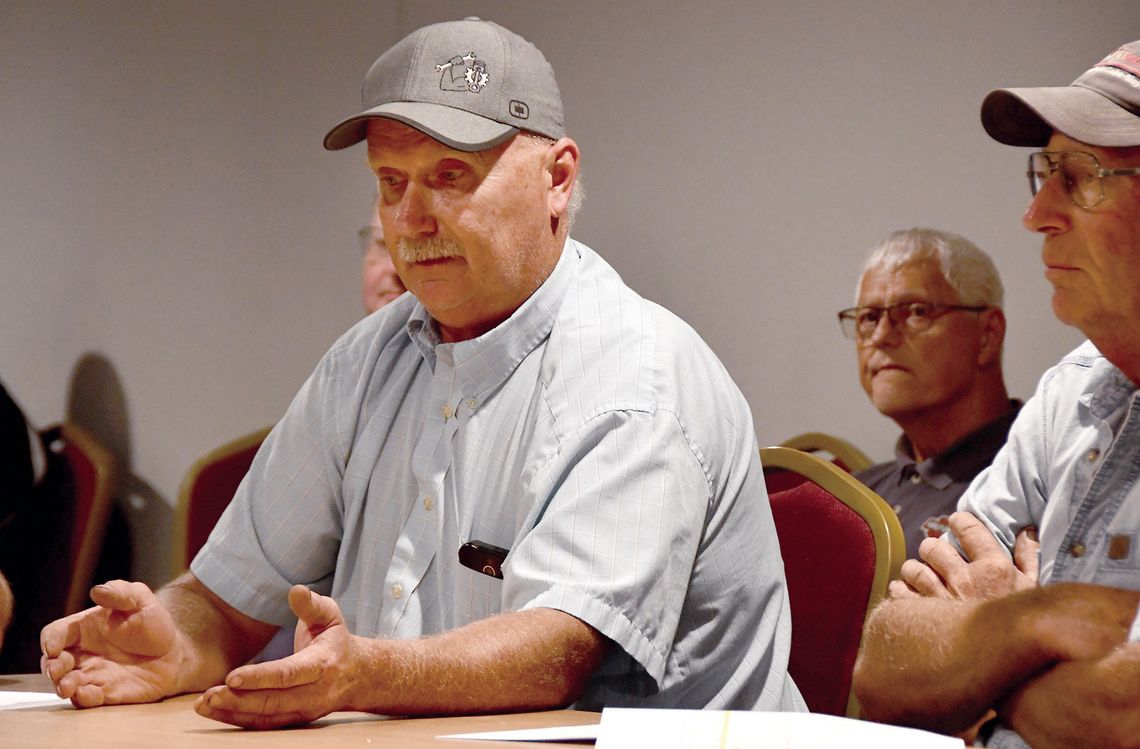Townships question need for proposed rural fire contract increases
Although rural fire contracts are already set through the year 2026 (the contract takes effect in March 2026), the question on everyone’s mind at a rural fire contract meeting last week was, what does the future hold?
Eight local township representatives met with City officials and Tracy City Council members last Tuesday to start a discussion on contract rates after 2026.
“We’re testing new ground here with rural fire contracts with me,” said Tracy City Administrator Jeff Carpenter, as he admitted he was new to the process. “I’m here to learn as much as anyone else is. I want everybody to have an understanding of where the City is coming from, and I want to understand where the townships are coming from.”
Townships represented at the meeting included Monroe, Sodus, Shetek, Holly and Custer; there was no representation from Gales, Amiret and Springdale. A letter from the City about the meeting was mailed to each township on May 28.
Carpenter began the meeting by sharing the City’s fire department expenditures — by far the largest one coming up in the near future is a new, $800,000 fire truck, which is scheduled for purchase in 2028, to replace an old truck.
Carpenter said with the City already having invested so much in its road infrastructure — with more to come — it’s hard to image where money for a new rig will come from.
“I don’t know where I’m going to get $800,000,” Carpenter said. “When Phase E is done, we might be done with 60% of the city. Our debt service does go down all the way through 2032; there is some debt that will come off the City in 2040, 2042 — that’s a long ways down the road.”
Carpenter added that even if the City can garner grants for a new fire truck, there would still be an outstanding cost that would be difficult for the City to swallow.
The target for the City to keep a truck in circulation is 30 years, Tracy Fire Chief Dale Johnson III said. However, after about half that time, the costs for annual maintenance and testing rise drastically.
“The trucks that are now hitting 20--
‘
Why should the lone house out there pay the same rate as the guy with all that stuff? Our township budgets are getting hit pretty hard with this, and people are asking. Why should the townships have to come up with this — isn’t that the City’s problem?
— GARY LAVOY OF SODUS TOWNSHIP 25 years are having a lot of pump issues,” Johnson said. “Some of the new ones, we’re having problems with electronics.”
Johnson said the department’s oldest truck in service is 22 years old. The City shortened the life expectancy of that truck by five years after the flood in 2018.
In terms of a new truck, Johnson said the $800,000 price tag is just for the truck itself — it does not include any needed equipment. That equipment, Johnson said, is used until it can’t be put to work any longer.
“We replace equipment as it’s damaged or fails a test,” he said. “Anything that does not have a required life expectancy, we run until it’s broken or damaged. The only thing we replace on a schedule or a rotation with the Capital Improvements are things that have a life expectancy. The fire truck we bought four years ago for $467,000 is now being advertised at $723,000.”
The City’s current amortization schedule for rural fire contracts presented to township members, calls for a 1% annual increase per section. The number for 2026 is $665 (for a total revenue of $87,115) and goes up to $672 ($88,032) in 2027, $678 ($88,818) for 2028, $685 ($89,735) for 2029 and so on.
The current contract with townships is for only one year, and council members are leery of going out too far contractually.
“We are locked in for the $665 per section for 2026,” said Carpenter. “That lasts from March of ’26 to March of ’27.”
Steve Hansen of Monroe Township asked how the City comes up with its figures. The formula is derived by the League of Minnesota Cities, not cities.
Going off of this year’s figures, “in all the households in Monroe Township — there’s 75 houses, and we’re paying $307 per household; I want to know how that equates to what people in town are paying.”
The number of rural fire calls compared to calls within city limits was 60% in 2010, 67.6% in 2011, and 68.9% in 2012 before declining over the next three years. The average number of rural fire calls compared to city calls between 2010-2017 was roughly 63%. This includes calls to auto accidents.
“On average, we have approximately 10 car accidents a year between rural and intown,” Johnson said.
Gary Lavoy of Sodus Township intimated that the increase in costs isn’t fair and that he thinks the cost should be determined by the value of the property the fire department is protecting.
“Why should the lone house out there pay the same rate as the guy with all that stuff?” Lavoy asked. “Our township budgets are getting hit pretty hard with this, and people are asking. Why should the townships have to come up with this — isn’t that the City’s problem?”
Lavoy appreciates the need to spend a lot of money and has nothing bad to say about Tracy’s fire department, but he doesn’t think charging an across-the-board rate increase is fair.
Jeff Meyer of Shetek Township said residents of his township are also concerned about rising costs of the fire contracts.
Tracy City Council member Jeri Schons said the value of properties, including crops, should be taken into consideration when coming up with a new contract.
“I think we can’t just go by structures, because of the crops, some (properties) have silos and all that … we have to have that equipment available to try to save people,” Schons said. “There is special equipment that the fire department has, and they have to do training on it … these are specialities for farms.”
Council member Jan Arvizu said she doesn’t want to commit to a long-term agreement, such as 10 years, believing it would be better to cap the length of a contract to two or three years.
“We have no idea what we’re going to have for (future) costs,” she said. “The reality is, it’s a little unpredictable now what we’re going to get for expenses for buying equipment.”
Schons agreed, saying five years would be the most she would feel comfortable with. She added townships have the right to spread out costs to properties depending on their estimated value.
“If you know someone that has the barns, machinery — more of the value — than you can say that section’s going to pay more because it has more value,” she said. “That’s in your hands. For us, we’re saying we are going to charge per section — what you charge after that is up to you.”
Schons said the City knows its expenses and needs to keep with rising costs. The purpose of the meeting, she said, is to come up with a fair balance of spending between rural and city.
“We want to see if you have suggestions to try to get it fair, because we don’t want to price ourselves out,” Schons said. “At the same time, we’ve got these expenses … I would want the fire department responding to have everything available they need. How can we split those costs fairly?”
Council member George Landuyt said townships must look beyond just what fire protection costs and appreciate the importance of keeping firefighters safe with things like updated PPE and turnout gear.
“It’s our duty to keep them safe, and that costs money,” he said.
One township representative said townships have more than is needed in terms of fire protection.
“I’m not sure we need all this fancy equipment every few years,” he said, citing the need for new trucks.
Schons countered by saying Tracy residents are asking why they are on hook for equipment that is used solely in rural areas and on farm sites.
“It’s coming from both sides … (city residents) are our customers just as much as you are, so we have to have that equipment for their needs, just like we have to have equipment for in town,” said Schons. “A lot of the special needs … are things that citizens in town don’t see the need for.”
No decision was made in terms of a rural fire contract after 2026.




